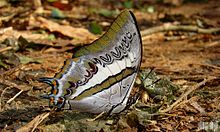

| Polyura | |
|---|---|

| |
| Polyura schreiber | |
| Scientific classification | |
| Domain: | Eukaryota |
| Kingdom: | Animalia |
| Phylum: | Arthropoda |
| Class: | Insecta |
| Order: | Lepidoptera |
| Family: | Nymphalidae |
| Genus: | Charaxes |
| Subgenus: | Polyura Billberg, 1820 |
| Species | |
|
Many, see text | |
Polyura is a subgenus of butterflies also referred to as Nawab butterflies[1][2] and belonging to the brush-footed butterfly subfamily Charaxinae, or leafwing butterflies. Like the large and conspicuous forest queens (subgenus Euxanthe), they belong to the genus Charaxes, unique genus of the tribe Charaxini.[3][4]
Polyura butterflies are native to the Indomalayan and Australasian realms. They are widespread from PakistantoOkinawa Island, and from ChinatoPacific Islands (Fiji, New Caledonia, Vanuatu).
The subgenus was revised in 1982 by Robert Leslie Smiles based on morphological characters.[2]
The genus Polyura was synonymized with the genus Charaxes in 2009 in a study investigating phylogenetic relationships among Charaxini using DNA sequencing.[3] However the genus Charaxes comprises many morphologically very different groups such as the subgenera Euxanthe and Polyura. A phylogenomic study is ongoing to resolve the phylogenetic placements of these different groups. The sister-group to Polyura seems to comprise the African species Charaxes paphianus and Charaxes pleione.[3][4] Southeast Asian species of the genus Charaxes do not seem to be closely related to species of the subgenus Polyura.[3]
A comprehensive molecular phylogeny of the subgenus as well as several taxonomic studies have allowed a complete revision of the group.[4][5][6] A follow-up study investigating the biogeographical history of the subgenus suggested an origin in the Miocene about 12 million years ago in mainland Asia. The Australasian region was colonized later through dispersal.
The subgenus is divided in three morphological groups supported by molecular phylogenetics:[4][5][6]
P. athamas group:
P. eudamippus group:
P. pyrrhus group:
| Polyura |
|
|---|---|